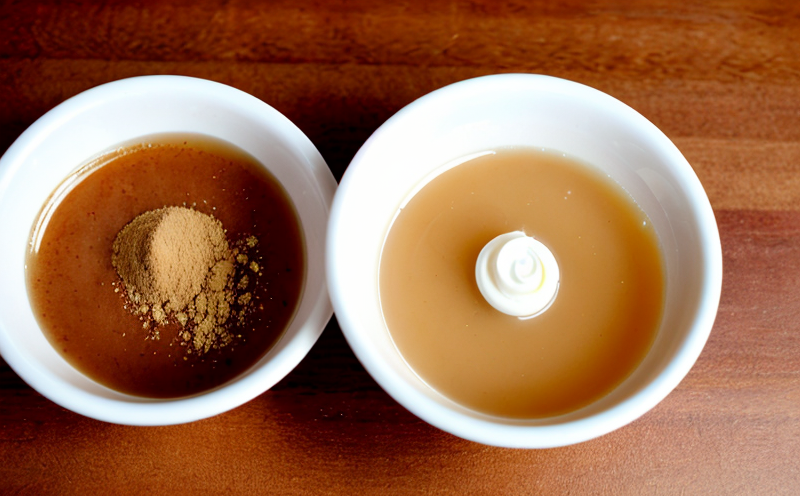DIN 10955 Sweetness Intensity Testing of Foods
The DIN 10955 standard provides a standardized method for determining sweetness intensity in foods, which is crucial for the development and quality control of sweetening agents like sucralose, aspartame, and other high-intensity sweeteners. This test ensures that products meet regulatory requirements and consumer expectations regarding taste and safety.
The standard specifies procedures to measure the relative sweetness intensities of different sweeteners based on their sensory evaluation by trained panelists. The method is widely used in the food industry for research, development, quality assurance, and compliance purposes. By adhering to DIN 10955, companies can ensure that their products are consistently perceived as expected by consumers.
The test involves a series of steps, including preparation of the samples, administration to trained panelists, and statistical evaluation of the results. The standard ensures consistency and comparability across different batches or production runs. This is particularly important for high-intensity sweeteners, which are used in various food products such as beverages, confections, and dietary supplements.
The DIN 10955 method requires careful preparation of test solutions to ensure accurate results. The samples must be prepared according to specific guidelines provided by the standard, including dilution ratios and volume adjustments for the taste tests. Trained panelists then evaluate the sweetness intensity of each sample using a standardized scale.
The evaluation process is rigorous, involving multiple rounds of testing under controlled conditions to minimize variability in results. This ensures that the test results are reliable and reproducible. The standard also provides guidance on statistical analysis to determine significant differences between samples, which aids in decision-making during product development and quality control.
Compliance with DIN 10955 is essential for companies operating within the EU and other regions where this standard is recognized. Non-compliance can lead to regulatory issues, consumer dissatisfaction, and potential recalls or withdrawals from markets. The standard helps manufacturers ensure that their products meet market expectations and regulatory requirements.
The importance of sweetness intensity testing cannot be overstated in the food industry. It allows for precise control over product formulations, ensuring consistency in taste across different batches and production lines. This is especially critical for high-intensity sweeteners, which are used in a wide range of products to enhance flavor while reducing calorie content.
By adhering to DIN 10955, companies can ensure that their products meet consumer expectations and regulatory standards. The method provides a reliable and consistent way to evaluate sweetness intensity, which is essential for maintaining product quality and safety. This standard plays a crucial role in the development of new products and the continuous improvement of existing formulations.
The DIN 10955 method also helps companies stay ahead of market trends by enabling them to introduce innovative sweeteners that meet consumer demands. By providing accurate sweetness intensity data, the standard supports research and development efforts aimed at improving product taste and reducing sugar content in food products.
In conclusion, compliance with DIN 10955 is critical for companies operating in the food industry. It ensures consistency in sweetness intensity testing, which is essential for maintaining product quality and safety. By adhering to this standard, companies can ensure that their products meet regulatory requirements and consumer expectations.
Why It Matters
The DIN 10955 method is crucial in the food industry for ensuring the accuracy and consistency of sweetness intensity testing. This standard is particularly important for high-intensity sweeteners, which are used in a wide range of products to enhance flavor while reducing calorie content.
Compliance with DIN 10955 ensures that companies meet regulatory requirements and consumer expectations regarding taste and safety. The method provides a reliable and consistent way to evaluate sweetness intensity, which is essential for maintaining product quality and safety. This standard plays a crucial role in the development of new products and the continuous improvement of existing formulations.
The importance of sweetness intensity testing cannot be overstated in the food industry. It allows for precise control over product formulations, ensuring consistency in taste across different batches and production lines. This is especially critical for high-intensity sweeteners, which are used in a wide range of products to enhance flavor while reducing calorie content.
By adhering to DIN 10955, companies can ensure that their products meet consumer expectations and regulatory standards. The method provides a reliable and consistent way to evaluate sweetness intensity, which is essential for maintaining product quality and safety. This standard plays a crucial role in the development of new products and the continuous improvement of existing formulations.
The DIN 10955 method also helps companies stay ahead of market trends by enabling them to introduce innovative sweeteners that meet consumer demands. By providing accurate sweetness intensity data, the standard supports research and development efforts aimed at improving product taste and reducing sugar content in food products.
Benefits
- Ensures consistency in sweetness intensity testing across different batches and production runs.
- Supports research and development efforts aimed at improving product taste and reducing sugar content in food products.
- Facilitates compliance with regulatory requirements and consumer expectations regarding taste and safety.
- Provides a reliable and consistent way to evaluate sweetness intensity, which is essential for maintaining product quality and safety.
- Aids in the development of new products by enabling companies to introduce innovative sweeteners that meet market trends.
- Supports continuous improvement of existing formulations through accurate sweetness intensity data.





